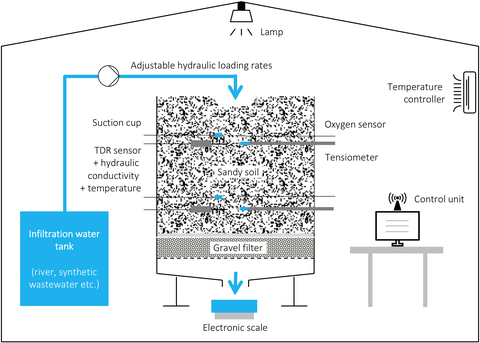Three-dimensional big-scale rectangular infiltration tank
The purpose of the three-dimensional infiltration tank is the assessment of clogging processes respectively changing infiltration capacities as well as the degradation processes of infiltrated organic substances and the vadose zone oxygen dynamics under different process and site-specific conditions (soil types, hydraulic loading cycles and climate).

INOWAS Lab tank
The stainless steel infiltration tank has the size of L = 1.50 m; W = 1.00 m; H = 1.00 m and is equipped with an infiltration basin (L = 0.44 m; W = 0.27 m; H = 0.06 m) installed in the centre of its surface. The tank is packed with sand (0.85 cm thick layer) on top of a 0.12 m gravel layer. For determination of spatial and temporal distribution of soil moisture, several tensiometers (tensio160, UGT GmbH) and TDR sensors (UMP-1, UGT GmbH) are installed at 0.28 m and 0.68 m below surface with three sensors per level. Suction cups (UGT GmbH) are installed for sampling pore water in the unsaturated soil zone. Additional fiber-oxygen sensors (Pyroscience GmbH) are installed to measure oxygen consumption. An electronic scale is placed at the outlet of the tank to determine the discharge of water over time. The tank is placed inside a fully automatic climate tent, which facilitates the exact control of air temperature and humidity.
River water from the Elbe river with an average DOC concentration of 30 mg/l and an average TSS concentration of 25 mg/l is infiltrated from the top with alternating wetting and drying phases.
